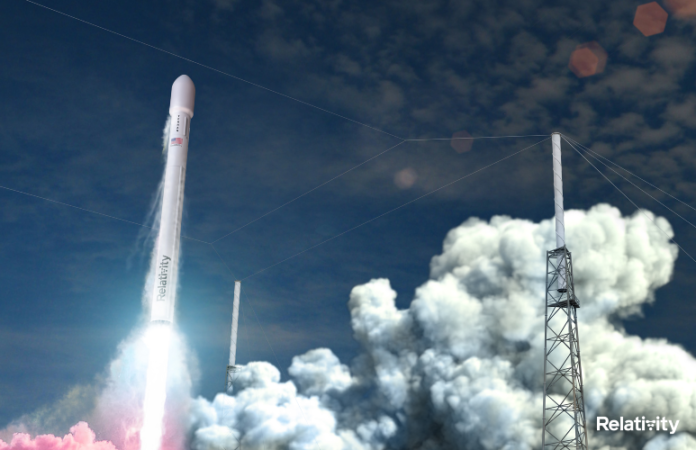The Long Beach-based company has seen tremendous growth in the past year as it works to prove its first-of-a-kind concept, building rockets using only 3D printers.
Relativity has raked in nearly $1.2 billion in funding over the past 12 months — bringing its valuation to $4.2 billion — and expanded its local campus by 1 million square feet. It has also hired hundreds of staff ahead of its first launch, which is scheduled for the end of the year.
And the company’s customer waitlist is filled with heavy-hitters in aerospace and telecommunications, including NASA, the Defense Department and Telesat.
“We’re just doing something that’s never been done before,” said Karin Kuo, vice president of people at Relativity. “I think we all want to be a part of this historic story — to be able to say, ‘I had a hand in being able to design, build and launch the world’s first wholly 3D-printed rocket.’”
Relativity uses massive metal 3D printers that it designs and builds in-house. The company claims the printers can create a single rocket from raw materials in 60 days, cutting down on time and labor costs.
Though other rocket-makers have used 3D printing to manufacture individual parts, Relativity is the first company to attempt a build using only 3D printers.
And that’s not even its boldest goal.
The company sees the rockets as a means to prove the capabilities of its 3D printers. Its founders ultimately want to establish an industrial base on Mars using 3D printing manufacturing and automation.
To investors, those lofty ambitions are enticing.
Vipin Khare, director of research at the India headquarters of Playa Vista-based William O’Neil & Co. Inc., said many investors are attracted to “high-risk, high-reward” companies. That’s especially true of Relativity, he said, given its promises for rapid rocket production.
“The less people know about the concept, or the newer it is, the more interest you will have among seasoned investors,” Khare said.
Investors have rallied behind Relativity from the start. The company was founded in 2015 by former Blue Origin engineer Tim Ellis and former Space Exploration Technologies Corp. engineer Jordan Noone. The two had met as students at USC.
In 2016, their startup joined Cambridge, Mass.-based Y Combinator, a renowned accelerator that has turned out companies such as DoorDash Inc., AirBnB Inc., Coinbase Global Inc. and Reddit Inc. Several of Relativity’s investors have participated in multiple funding rounds, including Tribe Capital, Tiger Global Management and Zillow Group Inc. founder Spencer Rascoff.
Over the past five years, Relativity has expanded to six locations nationally and has a staff of around 500 with plans to add 150 more employees by the end of the year.
A strong year
A strong year
In June, Relativity raised $650 million in Series E funding, doubling its total to $1.3 billion. Its investors include several Fidelity Management and Research Co., Centricus Asset Management and Soroban Capital Partners, as well as “Shark Tank” investor Mark Cuban and actor Jared Leto.
Kuo said interest from investors comes from several factors, including Relativity’s “high-caliber” team and the fact that the company’s mission is tied to making humanity’s future “multiplanetary.”
“We are … really bold about wanting to tie our company vision and mission to Mars, specifically around building that industrial base on Mars,” Kuo said.
Relativity’s promise to increase the speed of production by 5 to 10 times that of other companies is also a major draw, Khare said.
“For any emerging concept or something that is doing things dramatically faster, there is bound to be interest,” he said.
In tandem with its funding announcement in June, Relativity unveiled plans for its newest rocket, the Terran R, which it describes as a 216-foot-tall, 16-foot-diameter two-stage rocket with a 5-meter payload fairing that is expected to begin flying in 2024.
Relativity said Terran R will be able to carry payloads 20 times larger than the Terran 1, its flagship rocket design, can. Terran 1 will be used for smaller payloads.
According to the company, Terran R’s seven engines, which are scaled, high-pressure versions of those in Terran 1, will be capable of launching 302,000 pounds each and will be designed to carry more than 20,000 kilograms to low-Earth orbit.
Relativity’s rockets are built with fewer than 1,000 parts, rather than the 100,000 or more required in the traditional rocket manufacturing process, the company said.
Ellis said many aerospace companies are slower to innovate their products due to manual labor and the complicated nature of the aerospace supply chain.
“Relativity is at the forefront of this inevitable shift toward software-driven manufacturing,” he said in a statement.
New headquarters
New headquarters
In 2018, Ellis told Forbes he aimed to launch the first Relativity rocket by late 2020 or early 2021. As of now, Ellis said, Terran 1 “is launching to orbit at the end of this year.” The plan is for the rocket to blast off from Launch Complex 16 in Cape Canaveral, Fla.
Kuo said this first launch will be a demo, but that hasn’t stopped customers from lining up to get in on a future Relativity launch, for which the company will charge at least $12 million.

